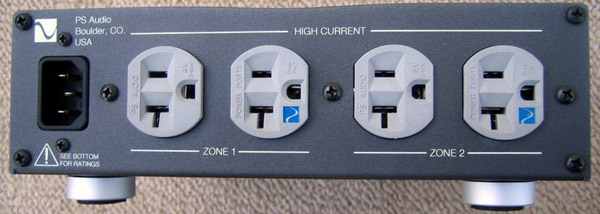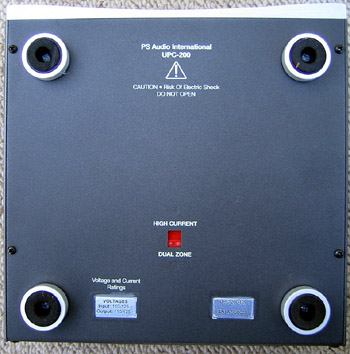Introduction
Power conditioning. For the most part my brain starts
thinking snake oil, overpriced, and generally not needed. Funny how things
change when you have a power-related issue in your system.
I recently purchased a
front projector and had a different wiring configuration than before. I
started getting a rolling banding problem while watching
DVDs. Looking for potential issues, I finally narrowed it down to most likely
being a ground loop problem. AC Line Conditioners can sometimes cure this
problem, and Kris Deering suggested I
have a look at the PS Audio UPC-200 Power Center.
The Design
The UPC-200 is a very nice looking unit with a brushed
aluminum faceplate and a blue LED indicator. It has four outlets on the back panel. The outlets are split into
two zones, each capable of handling 20 amps of current.
There is a switch
underneath the unit allowing you combine the zones to use one ultra-high
current device. Overall it is a solid and well put together product. My only
complaint about the design is that the LED indicator is really bright, to
the point it increases my ambient light for movies. A piece of dark tape
over the LED will cure that however.

The Technology
The UPC-200 is a passive power conditioner, meaning
that it passes the existing power (from your wall AC socket) through, with
filtering along the way. An active conditioner - like PS Audio’s own Powerplant line
- actively changes the waveform with powered electrical circuits.
It is relatively small, and as a
bonus, has completely isolated power banks. The UPC-200 has four outlets, two
pairs of outlets completely separate from the other. The design is meant to
function as a one-way gate for noise, so even if you plug a noisy piece of
electronics into one side, the other side will be completely isolated from
the noise on the first side.
 The
core of the UPC-200 is the Balun. What the heck is a Balun? It stands for
BALanced-UNbalanced, and it is what will stop any ground loop issues dead in
its tracks. PS Audio uses a specially designed balun, namely a toroid (think donut) wound with Litz (multi-stranded) wire, in a potting
cup and surrounded with epoxy.
The
core of the UPC-200 is the Balun. What the heck is a Balun? It stands for
BALanced-UNbalanced, and it is what will stop any ground loop issues dead in
its tracks. PS Audio uses a specially designed balun, namely a toroid (think donut) wound with Litz (multi-stranded) wire, in a potting
cup and surrounded with epoxy.
This approach takes care of noise and ground
loops across all frequencies with minimal power loss. Some passive
conditioners use filters in series to address different high frequency bands
and choke the power by forcing it through lots of small gauge coils. The
UPC-200 uses two “Power Cells” each with a Balun and other components. Each
creates a completely isolated source of power, that is, isolated from each other and
isolated from the outlet. Both banks are bi-directional and cut noise both
in and out.
In addition to cleaning the power, the UPC-200 also
protects. The power center uses a dual-stage approach to provide foolproof
protection. The first line of defense is something PS Audio calls a “Tranzorber”,
which instantaneously clamps spikes. These are
seen more often than the massive indirect lightning
levels. The Tranzorber can take thousands of hits up to 9 kV without
degrading and do so at an extremely fast level.
If you get an indirect
lightning strike or some other huge surge that the Tranzorber can’t handle,
the second line of defense are the MOVs (Metal Oxide Varistor). MOVs work great at handling huge
amounts of current and are found in most surge suppressors. They will react
to a surge by instantaneously shunting the surge to the neutral and ground
lines. MOVs do have a
drawback in that every spike they see degrades their
ability to respond quickly. That is why the UPC-200 has two levels of protection.
The Tranzorber in the first stage takes the smaller typical hits without
degrading, working much quicker than the second stage MOVs could, while also
protecting the MOVs from degradation. If you ever have one of those huge
surges, the Tranzorber and MOVs are on one user-removable and replaceable
board.
My Experiences
Well, I am not one to buy into huge gains in performance
by cleaning up some noise that is outside the ability of the amplifier to reproduce.
From a logical level, since the AC line will be completely
rectified into DC by the power supply in your amplifier anyway, I
have always figured what is the point? My first reaction to someone saying
they had better sound is that they are either using equipment with poor
power supplies or they did not do an A/B test.
Now that you know my bias, I
will let you know my listening impressions. The thing with a passive power
conditioner is that there is no bypass switch to take it out of the loop.
The equipment must be powered down, unplugged, plugged into a normal power
strip, and powered back up to the music track you are using. As this is a
rather tedious process, I chose only one track for my A/B, albeit a good
one, which was the title track from Laurence Juber’s Guitar Noir. This is a
phenomenal DVD-Audio recording from AIX, presented in 5.1 channels at 96 kHz
/ 24 bits.
With my skepticism and the inability to do a quick A/B I am
hesitant to say there was a huge improvement. However, I had to switch back
and forth four times and I finally came to the conclusion that I was hearing
a real difference. It was subtle, but there, the music was more alive, a
little more air presence in the guitar plucks, and a cleaner sound. I was
actually very surprised as I had fully convinced myself I would hear no
difference, but was proven wrong. Of course, there are those who will say
the "improvement" is totally psychological. Maybe.
However, there is no question as to the UPC-200's
effect on my video system.
I am not talking about any increased detail or more 3D video images, but a
total correction of a major issue I was having. Between my receiver, DVD
player, and projector, I was having a ground loop type issue which manifest
itself as a nasty
rolling banding noise on the screen. It was driving me absolutely
nuts! Then I got the UPC-200 and plugged my DVD player in one of the banks,
the receiver in the other, and my projector directly in the wall. This was
supposed to completely isolate my equipment and hopefully fix my issue. It
worked perfectly and as advertised. No noise, no banding, just a clean
picture. It was one of those benefits that anyone could see.
Conclusions
The PS Audio UPC-200 is something that I can whole
heartedly recommend. There is nothing about this product that says hype or
snake oil. The PS Audio UPC-200 is the real deal, from the subtle audio
improvements and full isolation of my video noise issues, to the top notch
surge and spike protection it delivers.
- Paul Taatjes -
Equipment used in this review:
Onix Rocket RS-850s (X5)
SVS PB2-Ultra
Denon DVD-2910 and Pioneer Elite DV-59AVi (i-link)
Pioneer Elite VSX-59TXi
Infocus Screenplay 4805
Behringer Feedback Destroyer Pro DSP1124 (PEQ)